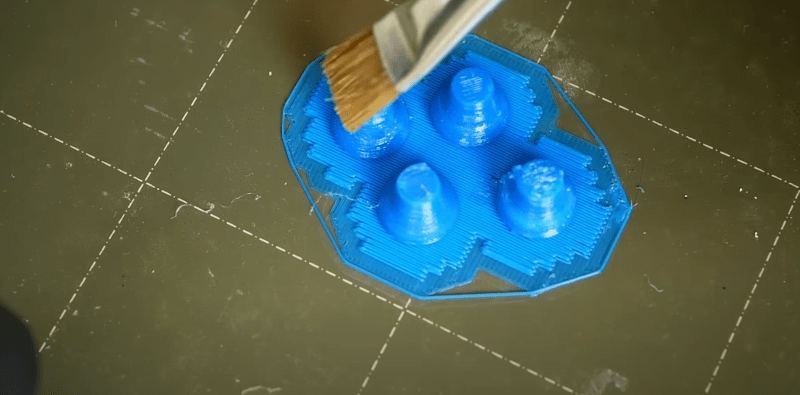If you have problems getting a 3D print to stick to the bed, you might consider using glue to — hopefully temporarily — attach the print to the bed. In addition, some plastics glue together well if you use a solvent. [Stefan] asks the question: What if you use solvent to glue each layer of a 3D print to the previous layer? The answer is in the video below.
If you know [Stefan], he is always meticulous, so the first test was with normal ABS parts. Then he used a solvent to glue two broken parts together to show how a single layer does with bonding. Then he moved toward trying the solvent for each layer.
Obviously, if you already knew this was a good idea, you’d want to rig up something to apply the solvent automatically. Since this was experimental, though, [Stefan] just had the gcode move the print head aside for each layer so he could manually apply the solvent. This was trickier than you might think because acetone boils off quickly from hot plastic. In addition, if it doesn’t boil off, it makes the existing layer swell, so the appearance of the parts wasn’t great.
Unfortunately, the strength of the printed parts was disappointing. ABS parts were not any better — and in some ways worse — than the reference parts. He then tried PVB which dissolves in alcohol. While it was easier than acetone, the results were not that great.
[Stefan] hopes there might be some process to make this work, but the simple methods he tried aren’t useful. It would be great if this simple idea would have led to stronger 3D printed parts. But as [Stefan] points out, negative results are important, too. Otherwise, we will all spend time trying things that won’t work repeatedly. Based on these results, you can try something different and maybe you’ll have better luck.
We really like the detailed and rigorous work [Stefan] does. From homebrewing high flow extrusion gear to putting bends in gcode, [Stefan] always has something interesting and well thought out.















Nice “fail”. There should be a website dedicated to “attempts”. It would avoid redundant experimenting….then again, maybe seemingly inconsequential differences would lead to a success!
Why do comment notifications never work anymore?!
Idea: a nozzle right by the extruder that drips or sprays solvent right in advance of the next deposit of filament.
Why not just use the movement of the extrusion/print head and a little capillary action to pull solvent out of the tank right at the point of contact – the small amount of solvent would likely flash cool the very outer edge of the hot extrusion so print speeds would probably need to be very very low as you are then reliant on the solvent that didn’t get boiled off as soon as it touched the hot plastic melting the two layers enough AND vaporizing sufficiently that the new material and old sticks well enough…
On the whole I think any solvent based method is just more effort than its worth, even if in theory it might work out well… No doubt about it using MEK or Acetone to bond ABS parts can create really damn close to if not better strength than the rest of the part(s) never touched by the solvent, but such nasty solvents should be avoided as much as possible – not that they can’t be used entirely safely, its just lots of extra work.
Maybe a dual extruder setup where the second, cold nozzle dispenses a measured quantity of solvent? Would increase the print time quite a bit.
Or just print in a heated chamber full of acetone vapor 🤣
And in the case of PETG on PEI remember to use some sort of de-bonding agent (hairspray, glue) so it doesn’t stick too well.
Using a fully enclosed printer box and the proper enclosure temperature and print temperature improves the layer adhesion by up to 30 percent. Early on, a laser was used to heat the prior layer and that improved layer adhesion by up to 50 percent on some materials – but requires complex laser attachment and software so that only the area ahead of the print head gets heated.
The laser solution provides excellent results, but the correct print temps and enclosure temps can get to 3/4 of that improvement with the existing tech and does not require an expensive add on and special software.
A rotating nozzle with a ‘sideways’ deposition port (so that plastic is always laid down ‘trailing’ the nozzle motion) would allow extrusion whilst contact-heating the part is passes over – and provides a free ironing pass for each layer. This technique is used in non-heated nozzles for concrete printing.
I’m thinking about attaching a hot air rework tool (custom nozzle) to the hotend and experimenting.
Don’t think the belts will like it, would require replacing all plastic with metal, jackscrews etc.
Might just be easier to build the whole thing inside a plastic annealing oven. Basically a fancy temperature controlled enclosure.